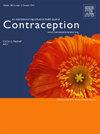Barriers to immediate postpartum long-acting reversible contraceptive provision in China: A qualitative study from the perspective of service providers
IF 2.3
2区 医学
Q1 OBSTETRICS & GYNECOLOGY
引用次数: 0
Abstract
Objectives
This study aimed to explore the barriers to immediate postpartum long-acting reversible contraception provision (LARC) from the perspective of obstetric health care providers in China.
Study design
The qualitative study involved hospital deputy directors, obstetric department chiefs, doctors, and nurses from obstetric departments in four hospitals (two in the eastern and two in the western regions of China). Data were collected through semistructured interviews and analyzed using thematic analysis.
Results
The study included 46 participants recruited from four hospitals that all offered intrauterine devices (IUDs) and implants but not immediate postpartum LARC services. Findings reveal that while all four hospitals offered IUDs and implants, none of their obstetric departments provided immediate postpartum LARC services. Significant barriers identified were the immediate postpartum LARC provision was not within the providers job responsibilities; the reluctance of most providers to recommend hormonal contraceptive methods to postpartum people due to concerns about the impact on breastfeeding and infant health; the nonprovision of immediate postpartum IUD placement was primarily due to fears of increased side effects such as pain, bleeding, and expulsion rates; and the provision might lead to potential medicolegal concerns.
Conclusions
The study reaches the conclusion that there are substantial barriers to the provision of postpartum LARC. These barriers mainly consist of concerns about reluctance to get involved in unnecessary trouble due to extra work, side effects, lack of knowledge about immediate postpartum LARC placement, and apprehensions regarding the potential impact on the doctor-patient relationship.
Implications
This study identifies key barriers to immediate postpartum long-acting reversible contraception provision in China, including provider concerns about side effects, lack of motivations, and limited policy support. Addressing these challenges through targeted interventions could improve long-acting reversible contraception provision, benefiting postpartum people in clinical practice.
中国产后立即提供长效可逆避孕措施的障碍:基于服务提供者视角的定性研究
目的:从中国产科医疗服务提供者的角度探讨产后立即长效可逆避孕(LARC)的障碍。研究设计:质性研究涉及中国四家医院(东部两家,西部两家)的医院副院长、产科主任、医生和产科护士。通过半结构化访谈收集数据,并使用专题分析进行分析。结果:该研究包括从四家医院招募的46名参与者,这些医院都提供宫内节育器和植入物,但不提供产后立即LARC服务。调查结果显示,虽然所有四家医院都提供宫内节育器和植入物,但它们的产科部门都没有提供产后即时LARC服务。确定的重大障碍是产后立即LARC提供不在提供者的工作职责范围内;由于担心对母乳喂养和婴儿健康的影响,大多数提供者不愿向产后妇女推荐激素避孕方法;未提供产后立即放置宫内节育器的主要原因是担心增加诸如疼痛、出血和排出率等副作用;该条款可能会引发潜在的医学上的担忧。结论:本研究得出的结论是,产后LARC的提供存在实质性障碍。这些障碍主要包括担心不愿意因额外的工作而卷入不必要的麻烦,副作用,缺乏对产后立即LARC放置的了解,以及担心对医患关系的潜在影响。
本文章由计算机程序翻译,如有差异,请以英文原文为准。
求助全文
约1分钟内获得全文
求助全文
来源期刊

Contraception
医学-妇产科学
CiteScore
4.70
自引率
17.20%
发文量
211
审稿时长
69 days
期刊介绍:
Contraception has an open access mirror journal Contraception: X, sharing the same aims and scope, editorial team, submission system and rigorous peer review.
The journal Contraception wishes to advance reproductive health through the rapid publication of the best and most interesting new scholarship regarding contraception and related fields such as abortion. The journal welcomes manuscripts from investigators working in the laboratory, clinical and social sciences, as well as public health and health professions education.
 求助内容:
求助内容: 应助结果提醒方式:
应助结果提醒方式:


